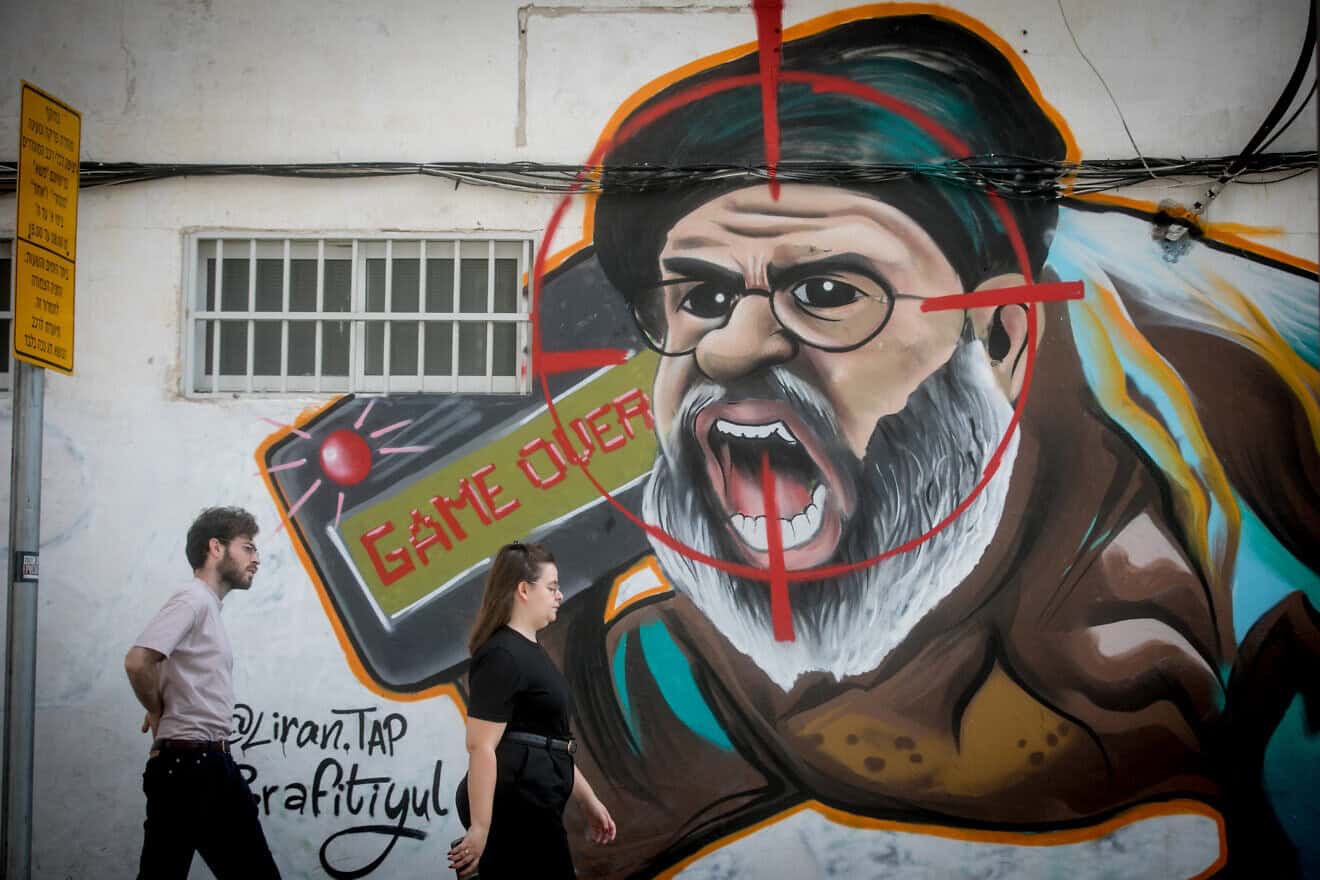Uncategorized
Hezbollah’s finances dry up as cash sources cut

Hezbollah is running out of money, as three of its main sources of cash dry up, the Voice of America (VOA) reported on Friday.
The Iranian terrorist proxy relies on three key funding channels: Al-Qard al Hasan, or AQAH, a Hezbollah-owned quasi-bank operating without a government banking license; Licensed Lebanese commercial banks: and cash from Iran, Researchers told the broadcaster.
Israel targeted AQAH in its initial airstrikes during the current campaign in Lebanon. They hit Hezbollah’s “cash storage centers, including a large part of the AQAH vaults,” leaving the group in a “financial crisis,” VOA reported, quoting a Sept. 30 report by Murr Television, aka MTV Lebanon.
Hilal Khashan, a political science professor at the American University of Beirut, also told the VOA that Israel “destroyed” most of AQAH’s branches.
“Hezbollah is facing a very serious financial problem. They are unable to pay rank and file members who have fled their homes and need to feed their families,” Khashan said.
The Meir Amit Intelligence and Terrorism Information Center (ITIC), a group of Israeli intelligence veterans, describes Al-Qard al-Hasan (“The Benevolent Loan”), as an institution that mainly provides interest-free loans to the Shi’ite community in Lebanon.
The main idea is to support Shi’ite society so that it in turn will support Hezbollah, becoming a “resistance society,” ITIC explained.
The U.S. Treasury Department sanctioned AQAH in 2007 and individuals associated with it in proceeding years. The sanctions did not, however, affect the number of loans provided by the organization, which continued to grow, ITIC said.
David Asher, a former U.S. Defense and State Department official who focused on Hezbollah’s drug trafficking and money laundering operations, told VOA that the group is in “deep trouble” as it is also losing access to Lebanese banking.
“I’m hearing from Lebanese bankers, including Hezbollah financiers, that Lebanon’s wealthiest bankers who can afford to fly have fled to Europe and the Gulf, fearing they could be targeted next by Israel for helping Hezbollah,” Asher said, now a senior fellow at the Washington-based Hudson Institute.
“These Lebanese bankers, most of them billionaires, see the wind is blowing against Hezbollah, so they are not going to let it take millions of dollars out of their banks, which still have cash despite being bankrupt on paper,” Asher said. “They know that if they do, Israel probably will eliminate them, too.”
Another Hezbollah funding source is cash delivered by plane from Iran. It, too, is drying up.
On Sept. 27, Israel warned it would not allow hostile flights carrying weapons to land at Beirut’s airport. The next day, an Iranian flight from Tehran made a U-turn over Iraqi airspace.
Lebanon’s Transport Ministry said it had ordered the Iranian plane to turn around after an Israeli threat that it would use force against Beirut’s air traffic control tower if the plane attempted to land.
“I’ve heard from my Israeli counterparts that the Iranians are scared to send money to Lebanon right now because Israel is threatening to target flights into Beirut. The Israelis are warning they will target flights full of money, not just weapons,” Asher said.
Uncategorized
NELLA MARGRITHE ESKIN NOVEMBER 14, 1946 – AUGUST 27, 2025

It is with great sorrow that the Eskin family reports the passing of Nella Margrithe Eskin, beloved wife and devoted partner of Michael Eskin, on August 27, 2025.
Nella, the only child of the late Kasiel and Rosa Kessler, Holocaust survivors, was born in a displaced persons camp in Fohrenwald, Germany, in 1946. The family first moved to Baltimore as refugees in 1949 before settling in Chicago, where Nella graduated from Roosevelt University with Bachelor of Science degree.
In 1969, she met Michael, and three months later they were married in Chicago in March 1970. They shared a wonderful marriage of over 55 years, during which they raised a family of four boys and created a home that was always full of song, food, guests and Yiddishkeit. Sadly, their eldest son, Katriel, passed away in 2015. Nella is survived by her other three sons, Josh, Ezra and Daniel, and their families as well as Katriel’s wife and family. She was a devoted wife, mother, and grandmother to her husband, sons, and ten grandchildren, and a loving daughter to her mother, Rosa, who passed away in 2020.
A lifelong scholar, she earned an MBA from the University of Manitoba in 1995. Nella was a very pious and learned woman who was also a wonderful artist, music lover, gardener and cook. She passed her love of music, art, storytelling and learning to her children, teaching each of them piano and instilling in them an enduring appreciation for the arts that continues to this day. She was an incredibly warm woman and made every gathering feel special, every guest feel valued, and every meal feel like a celebration of love and friendship.
She will be sorely missed by her husband, children, grandchildren, relatives in the UK, USA, Australia, and Israel, and many dear friends. Her kindness, curiosity, and love will live on in the many lives she touched. May her memory be
a blessing.
Uncategorized
VIDEO: Moishele Alfonso on the new book of I. L. Peretz stories for students
לכּבֿוד דער פּובליקאַציע פֿונעם ביכל „אויפֿן װעג: זיבן דערציילונגען פֿון י.־ל. פּרץ“ — אַ זאַמלונג ספּעציעל געמאַכט פֿאַר סטודענטן — קען מען איצט זען אַן אינטערוויו מיטן ייִדיש־לערער משהלע אַלפֿאָנסאָ, וואָס האָט פֿאַרקירצט און באַאַרבעט די דערציילונגען.
אין דעם אינטערוויו דערציילט אַלפֿאָנסאָ וועגן דעם פּראָצעס פֿון שאַפֿן דאָס ביכל, און לייענט געקליבענע אויסצוגן דערפֿון. דער אינטערוויו, געפֿירט פֿון אלי בענעדיקט, איז געשטיצט געוואָרן פֿון דער ייִדיש־ליגע, וואָס האָט אויך אַרויסגעגעבן דאָס לייענביכל.
דאָס נאָוואַטאָרישע ביכל גיט דעם לייענער אַ צוטריט צו קלאַסישע ייִדיש־דערציילונגען דורך אַ זײַט־בײַ־זײַטיקן גלאָסאַר, שמועס־פֿראַגעס און קלאַנג־רעקאָרדירונגען פֿון די מעשׂיות.
משהלע אַלפֿאָנסאָ איז אַ ייִדיש־לערער בײַם ייִדישן ביכער־צענטער זינט 2019. אין 2022 האָט ער, דורכן פֿאַרלאַג „אָלניאַנסקי־טעקסט“, טראַנסקריבירט און אַרויסגעגעבן יצחק באַשעוויסעס בוך „שׂונאים: די געשיכטע פֿון אַ ליבע“. דער ראָמאַן איז אַרויס אין המשכים אינעם פֿאָרווערטס אין 1966, און ס’איז דאָס ערשטע מאָל וואָס שׂונאים איז אַרויס אין בוכפֿאָרעם אויף ייִדיש.
דאָס ביכל קען מען באַשטעלן דאָ.
The post VIDEO: Moishele Alfonso on the new book of I. L. Peretz stories for students appeared first on The Forward.
Uncategorized
VIDEO: Peter, Paul and Mary’s “Light One Candle” — in Yiddish
If, like me, you enjoy listening to old recordings of the iconic folk group Peter, Paul and Mary, you may want to check this out: a new Yiddish version of their Hanukkah song “Light One Candle,” sung by another talented trio — Rabbi Avram, Elisha and Sarah Mlotek. (A transliteration of the lyrics appears beneath the video below.)
The three siblings are the grown children of Zalmen Mlotek, musician and director of the Yiddish National Theater Folksbiene, and his wife, Debbie Mlotek. Rabbi Avram is a writer, Elisha is a filmmaker and Sarah is studying music at a conservatory in Israel — and just became a mom.
Their singing is backed up by C. Joseph Lanzbom on guitar and Elisha on percussion.
The original song, which was written by Peter Yarrow, became an anthem for the Soviet Jewry movement in the 1980s, symbolizing their struggle for freedom. It was translated into Yiddish by the theater producer Moishe Rosenfeld and Avram Mlotek.
“‘Light One Candle’ was one of our Bubbe’s favorite songs every time we got together for a Hanukkah sing-along,” Avram said. Their Bubbe was the renowned scholar of Yiddish song, Chana Mlotek. For many years, she and her husband, the Yiddish cultural activist Yosl Mlotek, ran a column about Yiddish songs and poetry in the Forward.
Although Hanukkah is still a month away, Bubby Chana’s grandchildren had a meaningful reason for publishing it now: This week marks her yortzeit.
TRANSLITERATION
Eyn likht shaynt far di heldishe kinder
A dank vos dos likht geyt nit oys
Eyn likht shaynt far di payn un di laydn
Di sakone’z geven azoy groys
Eyn likht flakert far korbones un laydn
Az yoysher un frayhayt zol zayn
Eyn likhtl flakert far khokhme un visn
Far frayhayt un sholem zol zayn.
Lesht nit di likhtlekh oys!
Zey flakern shoyn doyres-lang
Lesht nit di likhtlekh oys!
Balaykhtn durkh undzer gezang!
Eyn likht flakert tsu gebn undz koyekh
Az eybik mir’n blaybn getray
Eyn likht flakert far mentshn vos laydn
Oykh mir zenen nisht geven fray
Eyn likhtl flakert far zise khaloymes
Tseteyln zol undz nisht der kas
Un eyn likhtl flakert tsu haltn tsuzamen
Mit sholem un mer nisht kayn has
Lesht nit di likhtlekh oys!
Zey flakern shoyn doyres-lang
Lesht nit di likhtlekh oys!
Balaykhtn durkh undzer gezang!
Vos iz di mayse vos iz azoy tayer
Vos lebt eybik in undzer flam?
Vos iz di shvue tsu fargangene doyres
Az es lebt undzer folk, undzer am?
Mir kumen, mir geyen, mir hofn, mir gloybn
Az yoysher vet vern der klal
Dos iz der viln, dos iz di shvue
A shenere velt iberal!
Lesht nit di likhtlekh oys!
Zey flakern shoyn doyres-lang
Lesht nit di likhtlekh oys!
Balaykhtn durkh undzer gezang!
The post VIDEO: Peter, Paul and Mary’s “Light One Candle” — in Yiddish appeared first on The Forward.


